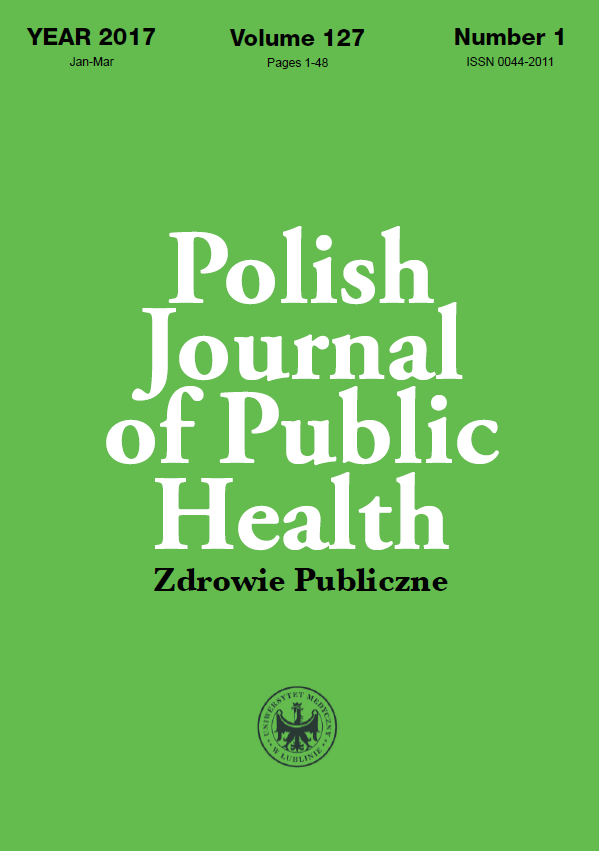Preventive examinations participation and satisfaction of women in peri- and postmenopausal age
DOI:
https://doi.org/10.1515/pjph-2017-0003Keywords:
women, breast cancer, screenings, mammography, attitudesAbstract
Introduction. Breast cancer is the second major cause of death in the world, after lung cancer. The purpose of screening tests is to diagnose cancer at non-clinical symptoms stage, when the prognosis is good and treatment less costly. Among different currently available screening methods, mammography plays a key role in early breast cancer detection.
Aim. The purpose of this work was to evaluate women’s in pre- and postmenopausal age in Lublin basic knowledge about preventive examination, their participation level and satisfaction with mammography.
Material and methods. The study included 258 women, participants of mammography examination at the Witold Chodzko Institute of Rural Health in Lublin and in Specialist Clinic of the Stefan Cardinal Wyszynski Province Specialist Hospital in Lublin, at the turn of years 2011/2012. The research method was a diagnostic survey and research tool – the Original Questionnaire.
Results. An opinion that prophylaxis should come as a result of aware lifestyle is not common (22.1% of participants is committed to expand their knowledge about health threats). Almost 20% of women has never participated in any prevention examination. Approximately 39% of respondents admitted that they have received an invitation for free examination in mammography mobile unit (MMU). Almost 52% respondents (out of those who correctly identified the term MMU) said that they are interested in visiting MMUs in the future.
Conclusions. The number of participants taking part in preventive examinations and in screening tests is unsatisfactory. Numerous subjective factors cause this situation. Many women still does not trust mammography tests made in mobile mammography facilities.
References
1. Smaga A, Mikułowska M, Komorowska A, et al. Rak piersi w Polsce. – leczenie to inwestycja. Warszawa: Roche Polska Sp. z o.o.;2014.
2. International Agency for Research on Cancer. World Health Organization; http://globocan.iarc.fr/Pages/fact_sheets_cancer.aspx [Available: 2015. 11.03]
3. Wojciechowska U, Didkowska J. Zachorowania i zgony na nowotwory złośliwe w Polsce. Krajowy Rejestr Nowotworów, Centrum Onkologii – Instytut im. Marii Skłodowskiej-Curie. [http://onkologia.org.pl.] (Available: 2015.11.12)
4. Perkins EA, Small BJ, Balducci L, et al. Individual differences in well-being in older breast cancer survivors. Crit Rev Oncol/Hematol. 2007;62:74-83. [Crossref]
5. Helgeson VS, Tomich PL. Surviving cancer: A comparison of 5-year disease-free breast cancer survivors with healthy women. Psycho-Oncology. 2005;14:307-17.
6. Manne SL, Ostroff JS, Norton TR, et al. Cancer-specific self-efficacy and psychosocial and functional adaptation to early stage breast cancer. Ann Behav Med. 2006;331(Suppl. 2):145-54.
7. Oh S, Heflin L, Meyerowitz BE, et al. Quality of life of breast cancer survivors after a recurrence: A follow-up study. Breast Cancer Res Treat. 2004;87:45-57.
8. Polska Unia Onkologii. Badania profilaktyczne. [http://www.puo.pl/badania-profilaktyczne/rak-piersi] (Available: 2015.11.12)
9. Godycki-Ćwirko M, Tomiak E, Wrzeciono B, et al. Zakres profilaktyki w podstawowej opiece zdrowotnej. Probl Med Rodz. 2009:11(Suppl. 1):15-22.
10. Gheonea IA, Donoiu L, Camen D, et al. Sonoelastography of breast lesions: a prospective study of 215 cases with histopathological correlation. Rom J Morphol Embryol. 2011;52(Suppl. 4):1209-14.
11. Leong LC, Sim LS, Lee YS, et al. A prospective study to compare the diagnostic performance of breast elastography versus conventional breast ultrasound. Clin Radiol. 2010;65(Suppl. 11):887-94. [Web of Science]
12. Wronkowski Z, Chmielarczyk W. Znaczenie badań przesiewowych w zwalczaniu raka piersi. Sł Zdr. 2000;24-26:2917-9.
13. Zapała E, Brożek J, Jaeschke R. Mammografia w badaniu przesiewowym w kierunku raka piersi–przegląd systematyczny. Med Prakt. 2007;02:148-50.
14. NFZ. Programy profilaktyczne. Populacyjny Program Wczesnego Wykrywania Raka Piersi (mammografia). [http://www.nfz.gov.pl/dla-pacjenta/programy-profilaktyczne/] (Available: 2015.11.12)
Downloads
Published
Issue
Section
License
Copyright (c) 2017 Polish Journal of Public Health

This work is licensed under a Creative Commons Attribution-NonCommercial-NoDerivatives 3.0 Unported License.


